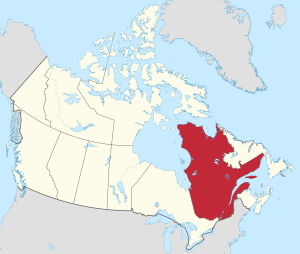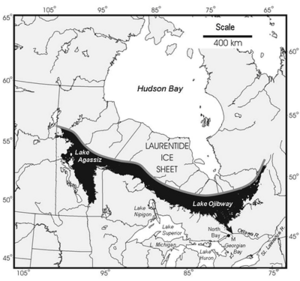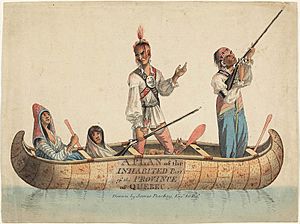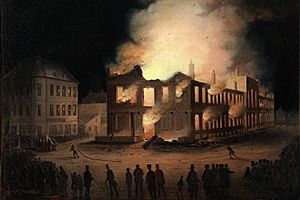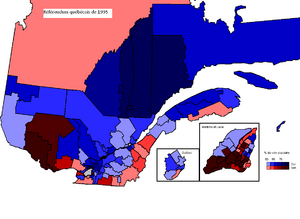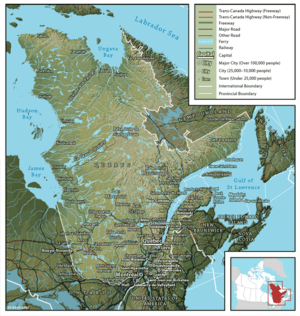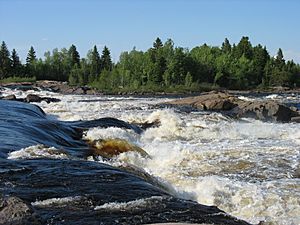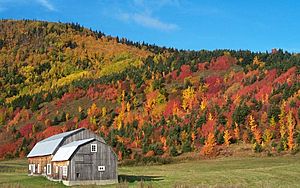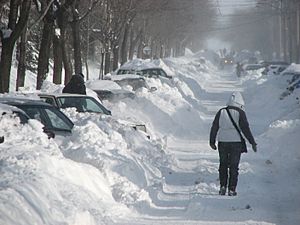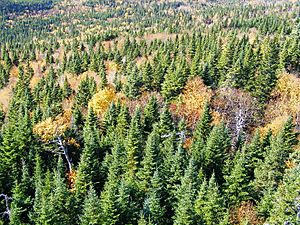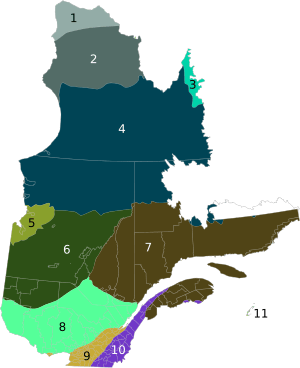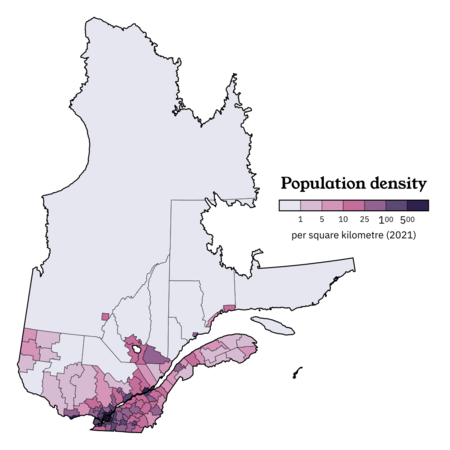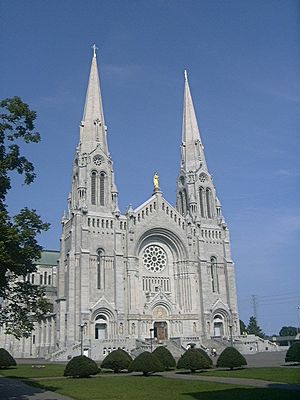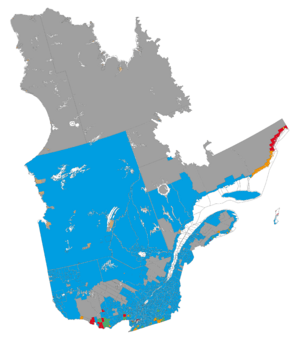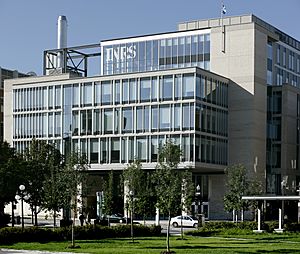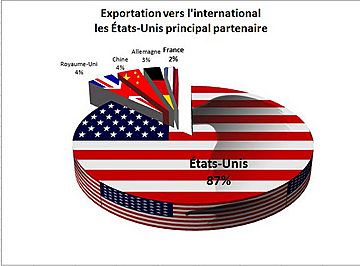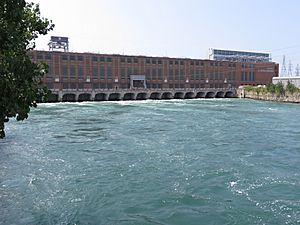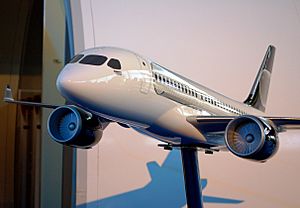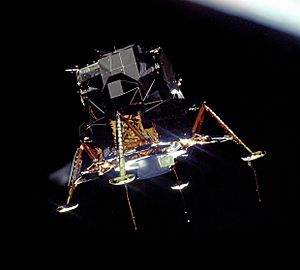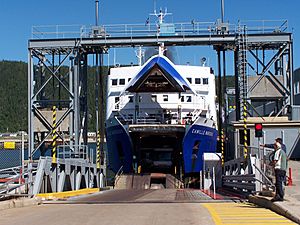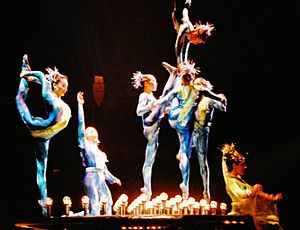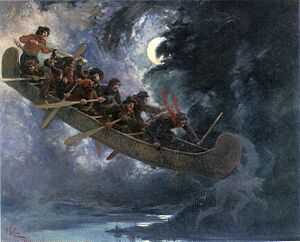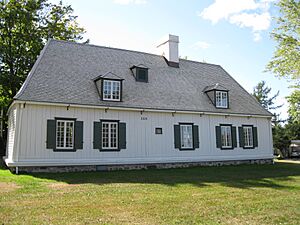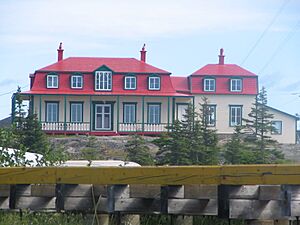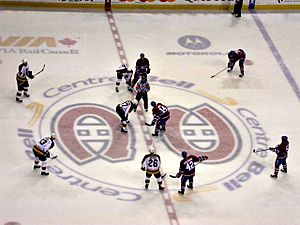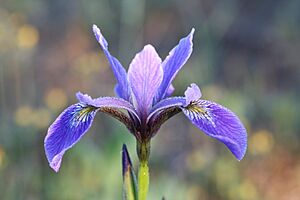Quebec facts for kids
Quick facts for kids
Quebec
Québec (French)
|
|||
|---|---|---|---|
|
|||
| Motto(s): | |||
| Country | Canada | ||
| Confederation | July 1, 1867 (1st, with New Brunswick, Nova Scotia, Ontario) | ||
| Capital | Quebec City | ||
| Largest city | Montreal | ||
| Largest metro | Greater Montreal | ||
| Government | |||
| • Type | Parliamentary constitutional monarchy | ||
| Area | |||
| • Total | 1,542,056 km2 (595,391 sq mi) | ||
| • Land | 1,365,128 km2 (527,079 sq mi) | ||
| • Water | 176,928 km2 (68,312 sq mi) 11.5% | ||
| Area rank | Ranked 2nd | ||
| 15.4% of Canada | |||
| Population
(2021)
|
|||
| • Total | 8,501,833 | ||
| • Estimate
(Q4 2024)
|
9,100,249 | ||
| • Rank | [[Population of Canada by province and territory|Ranked 2nd]] | ||
| • Density | 6.23/km2 (16.1/sq mi) | ||
| Demonym(s) | in English: Quebecer, Quebecker, Québécois in French: Québécois (m), Québécoise (f) |
||
| Official languages | French | ||
| GDP | |||
| • Rank | 2nd | ||
| • Total (2022) | C2.737 billion | ||
| • Per capita | C,651 (9th) | ||
| HDI | |||
| • HDI (2019) | 0.916—Very high ([[List of Canadian provinces and territories by Human Development Index|9th]]) | ||
| Time zone | UTC−05:00 (Eastern Time Zone for most of the province) | ||
| • Summer (DST) | UTC−04:00 | ||
| Postal abbr. |
QC
|
||
| Rankings include all provinces and territories | |||
Quebec is one of the thirteen provinces and territories of Canada. It is the largest province by area with an area of 1.5 million square kilometres (0.58 million square miles) and more than 12,000 km (7,500 mi) of borders, in North America, Quebec is located in Central Canada. The province shares land borders with the provinces of Ontario to the west, Newfoundland and Labrador to the northeast, New Brunswick to the southeast and a coastal border with the territory of Nunavut. To the north, it is flanked by major bodies of water such as James Bay, Hudson Bay, Hudson Strait, Ungava Bay, Arctic and Atlantic Oceans, and in the south, it shares a border with the United States. It is the second-largest province by population, with the majority of its population residing in the St. Lawrence River valley, which contains its most populous city of Montreal and the eponymous provincial capital of Quebec.
Between 1534 and 1763, what is now Quebec was the French colony of Canada and was the most developed colony in New France. Following the Seven Years' War, Canada became a British colony, first as the Province of Quebec (1763–1791), then Lower Canada (1791–1841), and lastly part of the Province of Canada (1841–1867) as a result of the Lower Canada Rebellion. It was confederated with Ontario, Nova Scotia, and New Brunswick in 1867. Until the early 1960s, the Catholic Church played a large role in the social and cultural institutions in Quebec. However, the Quiet Revolution of the 1960s to 1980s increased the role of the Government of Quebec in l'État québécois (the public authority of Quebec).
The Government of Quebec functions within the context of a Westminster system and is both a liberal democracy and a constitutional monarchy. The Premier of Quebec acts as head of government. Independence debates have played a large role in Quebec politics. Quebec society's cohesion and specificity is based on three of its unique statutory documents: the Quebec Charter of Human Rights and Freedoms, the Charter of the French Language, and the Civil Code of Quebec. Furthermore, unlike elsewhere in Canada, law in Quebec is mixed: private law is exercised under a civil-law system, while public law is exercised under a common-law system.
Quebec's official language is French; Québécois French is the regional variety. Quebec is the only Francophone-majority province. The economy of Quebec is mainly supported by its large service sector and varied industrial sector. For exports, it leans on the key industries of aeronautics, where it is the 6th largest worldwide seller, hydroelectricity, mining, pharmaceuticals, aluminum, wood, and paper. Quebec is well known for producing maple syrup, for its comedy, and for making hockey one of the most popular sports in Canada. It is also renowned for its culture; the province produces literature, music, films, TV shows, festivals, and more.
Contents
- Etymology
- History
- Indigenous peoples and European exploration
- New France
- Seven Years' War and capitulation of New France
- Quebec Act
- Effects of the American Revolution
- Patriotes' Rebellion in Lower Canada
- Canadian Confederation
- World War I and World War II
- Quiet Revolution
- Parti Québécois and national unity
- Statut particulier ("special status")
- Geography
- Law
- Demographics
- Economy
- Education
- Infrastructure
- Culture
- Emblems of Quebec
- Quebec's diaspora
- See also
Etymology
The name Québec comes from an Algonquin word meaning 'narrow passage' or 'strait'. The name originally referred to the area around Quebec City where the Saint Lawrence River narrows to a cliff-lined gap. Early variations in the spelling included Québecq and Kébec. French explorer Samuel de Champlain chose the name Québec in 1608 for the colonial outpost he would use as the administrative seat for New France.
History
Indigenous peoples and European exploration
At the time of first European contact and later colonization, Algonquian, Iroquois and Inuit nations controlled what is now Quebec. Their lifestyles and cultures reflected the land on which they lived. Algonquians organized into seven political entities lived nomadic lives based on hunting, gathering, and fishing in the rugged terrain of the Canadian Shield: (James Bay Cree, Innu, Algonquins) and Appalachian Mountains (Mi'kmaq, Abenaki). St. Lawrence Iroquoians, a branch of the Iroquois, lived more settled lives, growing corn, beans and squash in the fertile soils of the St. Lawrence Valley. They appear to have been later supplanted by the Mohawk nation. The Inuit continue to fish and hunt whale and seal in the harsh Arctic climate along the coasts of Hudson and Ungava Bay. These people traded fur and food and sometimes warred with each other.
New France
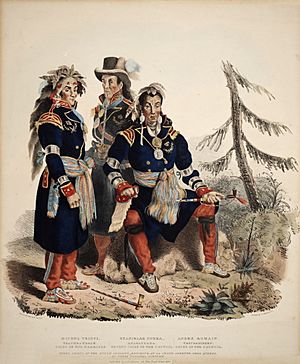
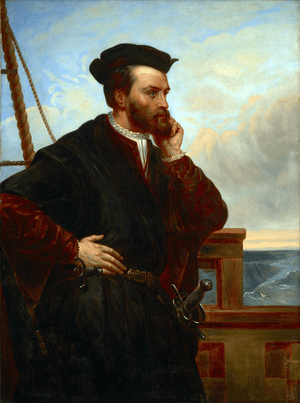
Around 1522–1523, the Italian navigator Giovanni da Verrazzano persuaded King Francis I of France to commission an expedition to find a western route to Cathay (China). In 1534, Jacques Cartier planted a cross in the Gaspé Peninsula and claimed the land in the name of King Francis I. It was the first province of New France. However, initial French attempts at settling the region met with failure. French fishing fleets, however, continued to sail to the Atlantic coast and into the St. Lawrence River, making alliances with First Nations that would become important once France began to occupy the land.
Samuel de Champlain was part of a 1603 expedition from France that travelled into the St. Lawrence River. In 1608, he returned as head of an exploration party and founded Quebec City with the intention of making the area part of the French colonial empire. Champlain's Habitation de Québec, built as a permanent fur trading outpost, was where he would forge a trading, and ultimately a military alliance, with the Algonquin and Huron nations. First Nations traded their furs for many French goods such as metal objects, guns, alcohol, and clothing.
Coureurs des bois, voyageurs and Catholic missionaries used river canoes to explore the interior of the North American continent. They establishing fur trading forts on the Great Lakes (Étienne Brûlé 1615), Hudson Bay (Radisson and Groseilliers 1659–60), Ohio River and Mississippi River (La Salle 1682), as well as the Saskatchewan River and Missouri River (de la Verendrye 1734–1738).
After 1627, King Louis XIII of France allowed the Company of New France to introduced the seigneurial system and forbade settlement in New France by anyone other than Roman Catholics.
In 1629 there was the surrender of Quebec, without battle, to English privateers led by David Kirke during the Thirty Years' War. However, Samuel de Champlain argued that the English seizing of the lands was illegal as the war had already ended; he worked to have the lands returned to France. As part of the ongoing negotiations of their exit from the Anglo-French War, in 1632 the English king Charles agreed to return the lands in exchange for Louis XIII paying his wife's dowry. These terms were signed into law with the Treaty of Saint-Germain-en-Laye. The lands in Quebec and Acadia were returned to the French Company of One Hundred Associates.
New France became a Royal Province in 1663 under King Louis XIV of France with a Sovereign Council that included intendant Jean Talon. The population grew slowly under French rule, thus remained relatively low as growth was largely achieved through natural births, rather than by immigration. To encourage population growth and to redress the severe imbalance between single men and women, King Louis XIV sponsored the passage of approximately 800 young French women (known as les filles du roi) to the colony. Most of the French were farmers ("Canadiens" or "Habitants"), and the rate of population growth among the settlers themselves was very high.
Seven Years' War and capitulation of New France
Authorities in New France became more aggressive in their efforts to expel British traders and colonists from the Ohio Valley. They began construction of a series of fortifications to protect the area. In 1754, George Washington launched a surprise attack on a group of Canadien soldiers sleeping in the early morning hours. It came at a time when no declaration of war had been issued by either country. This frontier aggression known as the Jumonville affair set the stage for the French and Indian War (a US designation; in Canada it is usually referred to as the Seven Years' War, although French Canadians often call it La guerre de la Conquête ["The War of Conquest"]) in North America. By 1756, France and Britain were battling the Seven Years' War worldwide. In 1758, the British mounted an attack on New France by sea and took the French fort at Louisbourg.
On September 13, 1759, the British forces of General James Wolfe defeated those of French General Louis-Joseph de Montcalm on the Plains of Abraham outside Quebec City. With the exception of the small islands of Saint Pierre and Miquelon, located off the coast of Newfoundland, France ceded its North American possessions to Great Britain through the Treaty of Paris (1763) in favour of gaining the island of Guadeloupe for its then-lucrative sugar cane industry. The British Royal Proclamation of 1763 renamed Canada (part of New France) as the Province of Quebec.
Quebec Act
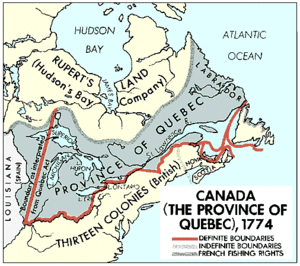
With unrest growing in the colonies to the south, which would one day grow into the American Revolution, the British were worried that the French-speaking Canadians might also support the growing rebellion. At that time, French-speaking Canadians formed the vast majority of the population of the province of Quebec (more than 99%) and British immigration was not going well. To secure the allegiance of the approximately 90,000 French-speaking Canadians to the British crown, first Governor James Murray and later Governor Guy Carleton promoted the need for change. There was also a need to compromise between the conflicting demands of the French-speaking Canadian subjects and those of newly arrived British subjects. These efforts by the colonial governors eventually resulted in enactment of the Quebec Act of 1774.
The Quebec Act provided the people of Quebec their first Charter of Rights and paved the way to later official recognition of the French language and French culture. The act also allowed Canadiens to maintain French civil law and sanctioned freedom of religion, allowing the Roman Catholic Church to remain, one of the first cases in history of state-sanctioned freedom of religious practice.
Effects of the American Revolution
Although the Quebec Act was unrelated to the events in Boston of 1773, and was not regarded as one of the Coercive Acts, the timing of its passage led British colonists to the south to believe that it was part of the program to punish them. The Quebec Act offended a variety of interest groups in the British colonies. Land speculators and settlers objected to the transfer of western lands previously claimed by the colonies to a non-representative government. Many feared the establishment of Catholicism in Quebec, and that the French Canadians were being courted to help oppress British Americans.
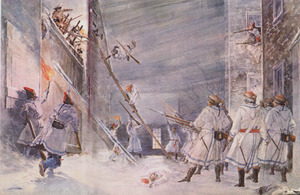
On June 27, 1775, General George Washington decided to attempt an invasion of Canada by the American Continental Army to wrest Quebec and the St. Lawrence River from the British. the invasion failed when British reinforcements came down the St. Lawrence in May 1776 and the Battle of Trois-Rivières turned into a disaster for the Americans. The army withdrew to Ticonderoga. Although some help was given to the Americans by the locals, Governor Carleton punished American sympathizers and public support of the American cause came to an end. In 1778, Frederick Haldimand took over for Guy Carleton as governor of Quebec.
The arrival of 10,000 Loyalists at Quebec in 1784 destroyed the political balance that Haldimand (and Carleton before him) had worked so hard to achieve. The swelling numbers of English encouraged them to make greater demands for recognition with the colonial government. To restore stability to his largest remaining North American colony, King George III sent Carleton back to Quebec to remedy the situation.
In ten years, Quebec had undergone a dramatic change. What worked for Carleton in 1774 was not likely to succeed in 1784. Specifically, there was no possibility of restoring the previous political balance – there were simply too many English people unwilling to reach a compromise with the 145,000 Canadiens or their colonial governor. The situation called for a more creative approach to problem solving.
Separation of the Province of Quebec
Loyalists soon petitioned the government to be allowed to use the British legal system they were used to in the American colonies. The creation of Upper and Lower Canada in 1791 allowed most Loyalists to live under British laws and institutions, while the French-speaking population of Lower Canada could maintain their familiar French civil law and the Catholic religion. Therefore, Governor Haldimand (at the suggestion of Carleton) drew Loyalists away from Quebec City and Montreal by offering free land on the northern shore of Lake Ontario to anyone willing to swear allegiance to George III. The Loyalists were thus given land grants of 200 acres (81 ha) per person. Basically, this approach was designed with the intent of keeping French and English as far apart as possible. Therefore, after the separation of the Province of Quebec, Lower Canada and Upper Canada were formed, each with its own government.
Patriotes' Rebellion in Lower Canada
In 1837, residents of Lower Canada – led by Louis-Joseph Papineau and Robert Nelson – formed an armed resistance group to seek an end to the unilateral control of the British governors. They made a Declaration of Rights with equality for all citizens without discrimination and a Declaration of Independence of Lower-Canada in 1838. Their actions resulted in rebellions in both Lower and Upper Canada. An unprepared British Army had to raise militia force; the rebel forces scored a victory in Saint-Denis but were soon defeated.
After the rebellions, Lord Durham was asked to undertake a study and prepare a report on the matter and to offer a solution for the British Parliament to assess. Following Durham's report, the British government merged the two colonial provinces into one Province of Canada in 1840 with the Act of Union. The two colonies remained distinct in administration, election, and law.
In 1848, Baldwin and LaFontaine, allies and leaders of the Reformist party, were asked by Lord Elgin to form an administration together under the new policy of responsible government. The French language subsequently regained legal status in the Legislature.
Canadian Confederation
In the 1860s, the delegates from the colonies of British North America (Canada, New Brunswick, Nova Scotia, Prince Edward Island, and Newfoundland) met in a series of conferences to discuss self-governing status for a new confederation. The first Charlottetown Conference took place in Charlottetown, Prince Edward Island, followed by the Quebec Conference in Quebec City which led to a delegation going to London, Britain, to put forth a proposal for a national union.
As a result of those deliberations, in 1867 the Parliament of the United Kingdom passed the British North America Acts, providing for the Confederation of most of these provinces. The former Province of Canada was divided into its two previous parts as the provinces of Ontario (Upper Canada) and Quebec (Lower Canada). New Brunswick and Nova Scotia joined Ontario and Quebec in the new Dominion of Canada. The other provinces then joined the Confederation, one after the other: Manitoba and the Northwest Territories in 1870, British Columbia in 1871, Prince Edward Island in 1873, Yukon in 1898, Alberta and Saskatchewan in 1905, Newfoundland in 1949 and finally Nunavut in 1999.
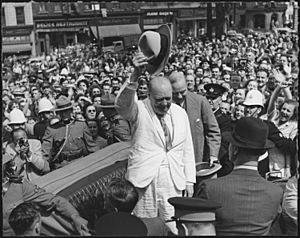
World War I and World War II
When Great Britain declared war on August 4, 1914, Canada was automatically involved as a dominion. About 6,000 volunteers from Quebec participated on the European front. Although reaction to conscription was favourable in English Canada the idea was deeply unpopular in Quebec. The Conscription Crisis of 1917 did much to highlight the divisions between French and English-speaking Canadians in Canada.
During World War II, the participation of Quebec was more important but led to the Conscription Crisis of 1944 and opposition. Many Quebecers fought against the axis power between 1939 to 1945 with the involvement of many francophone regiments such as Les Fusiliers Mont-Royal, le Régiment de la Chaudière and many more.
Quiet Revolution
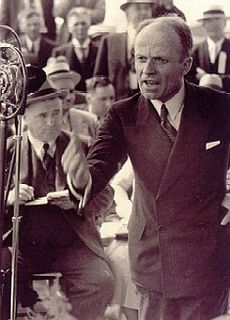
The conservative government of Maurice Duplessis and his Union Nationale dominated Quebec politics from 1944 to 1959 with the support of the Catholic Church. Pierre Trudeau and other liberals formed an intellectual opposition to Duplessis's regime, setting the groundwork for the Quiet Revolution under Jean Lesage's Liberals. The Quiet Revolution was a period of dramatic social and political change that saw the decline of Anglo supremacy in the Quebec economy, the decline of the Roman Catholic Church's influence, the formation of hydroelectric companies under Hydro-Québec and the emergence of a pro-sovereignty movement under former Liberal minister René Lévesque.
October Crisis
Beginning in 1963, a paramilitary group that became known as the Front de libération du Québec (FLQ) launched a decade-long series of propaganda and terrorism that included bombings, robberies and attacks directed primarily at English institutions, resulting in at least five deaths. In 1970, their activities culminated in events referred to as the October Crisis when James Cross, the British trade commissioner to Canada, was kidnapped along with Pierre Laporte, a provincial minister and Vice-Premier. Laporte was strangled with his own rosary beads a few days later. In their published Manifesto, the militants stated: "In the coming year Bourassa will have to face reality; 100,000 revolutionary workers, armed and organized." At the request of Premier Robert Bourassa, Prime Minister Pierre Trudeau invoked the War Measures Act.
Parti Québécois and national unity
In 1977, the newly elected Parti Québécois government of René Lévesque introduced the Charter of the French Language. Often known as Bill 101, it defined French as the only official language of Quebec in areas of provincial jurisdiction.
Lévesque and his party had run in the 1970 and 1973 Quebec elections under a platform of separating Quebec from the rest of Canada. The party failed to win control of Quebec's National Assembly both times – though its share of the vote increased from 23 percent to 30 percent – and Lévesque was defeated both times in the riding he contested. In the 1976 election, he softened his message by promising a referendum (plebiscite) on sovereignty-association rather than outright separation, by which Quebec would have independence in most government functions but share some other ones, such as a common currency, with Canada. On November 15, 1976, Lévesque and the Parti Québécois won control of the provincial government for the first time. The question of sovereignty-association was placed before the voters in the 1980 Quebec referendum. During the campaign, Pierre Trudeau promised that a vote for the "no" side was a vote for reforming Canada. Trudeau advocated the patriation of Canada's Constitution from the United Kingdom. The existing constitutional document, the British North America Act, could only be amended by the United Kingdom Parliament upon a request by the Canadian parliament.
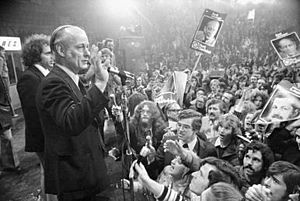
Sixty percent of the Quebec electorate voted against the proposition for sovereignty-association. Polls showed that the overwhelming majority of English and immigrant Quebecers voted against, and that French Quebecers were almost equally divided, with older voters less in favour and younger voters more in favour. After his loss in the referendum, Lévesque went back to Ottawa to start negotiating a new constitution with Trudeau, his minister of Justice Jean Chrétien and the nine other provincial premiers. Lévesque insisted Quebec be able to veto any future constitutional amendments. The negotiations quickly reached a stand-still. Quebec is the only province not to have assented to the patriation of the Canadian constitution in 1982.
In subsequent years, two attempts were made to gain Quebec's approval of the constitution. The first was the Meech Lake Accord of 1987, which was finally abandoned in 1990 when the province of Manitoba did not pass it within the established deadline. (Newfoundland premier Clyde Wells had expressed his opposition to the accord, but, with the failure in Manitoba, the vote for or against Meech never took place in his province.) This led to the formation of the sovereigntist Bloc Québécois party in Ottawa under the leadership of Lucien Bouchard, who had resigned from the federal cabinet. The second attempt, the Charlottetown Accord of 1992, also failed to gain traction. This result caused a split in the Quebec Liberal Party that led to the formation of the new Action démocratique (Democratic Action) party led by Mario Dumont and Jean Allaire.
On October 30, 1995, with the Parti Québécois back in power since 1994, a second referendum on sovereignty took place. This time, it was rejected by a slim majority (50.6 percent NO to 49.4 percent YES).
Statut particulier ("special status")
Given the province's heritage and the preponderance of French (unique among the Canadian provinces), there has been debate in Canada regarding the unique status (statut particulier) of Quebec and its people, wholly or partially. Prior attempts to amend the Canadian constitution to acknowledge Quebec as a "distinct society" – referring to the province's uniqueness within Canada regarding law, language, and culture – have been unsuccessful; however, the federal government under Prime Minister Jean Chrétien would later endorse recognition of Quebec as a distinct society.
On October 30, 2003, the National Assembly of Quebec voted unanimously to affirm "that the people of Québec form a nation." On November 27, 2006, the House of Commons passed a symbolic motion moved by Prime Minister Stephen Harper declaring "that this House recognize that the Québécois form a nation within a united Canada." However, there is considerable debate and uncertainty over what this means.
Geography
Located in the eastern part of Canada, and (from a historical and political perspective) part of Central Canada, Quebec occupies a territory nearly three times the size of France or Texas, most of which is very sparsely populated. Its topography is very different from one region to another due to the varying composition of the ground, the climate (latitude and altitude), and the proximity to water. The Saint Lawrence Lowland (south) and the Canadian Shield (north) are the two main topographic regions, and are radically different.
Hydrography
Quebec has one of the world's largest reserves of fresh water, occupying 12% of its surface. It has 3% of the world's renewable fresh water, whereas it has only 0.1% of its population. More than half a million lakes, including 30 with an area greater than 250 square kilometres (97 sq mi), and 4,500 rivers pour their torrents into the Atlantic Ocean, through the Gulf of Saint Lawrence and the Arctic Ocean, by James, Hudson, and Ungava bays. The largest inland body of water is the Caniapiscau Reservoir, created in the realization of the James Bay Project to produce hydroelectric power. Lake Mistassini is the largest natural lake in Quebec.
The Saint Lawrence River has some of the world's largest sustaining inland Atlantic ports at Montreal (the province's largest city), Trois-Rivières, and Quebec City (the capital). Its access to the Atlantic Ocean and the interior of North America made it the base of early French exploration and settlement in the 17th and 18th centuries. Since 1959, the Saint Lawrence Seaway has provided a navigable link between the Atlantic Ocean and the Great Lakes. Northeast of Quebec City, the river broadens into the world's largest estuary, the feeding site of numerous species of whales, fish, and seabirds. The river empties into the Gulf of Saint Lawrence. This marine environment sustains fisheries and smaller ports in the Lower Saint Lawrence (Bas-Saint-Laurent), Lower North Shore (Côte-Nord), and Gaspé (Gaspésie) regions of the province. The Saint Lawrence River with its estuary forms the basis of Quebec's development through the centuries. At the same time, many affluent rivers testify to the exploration of land, among them Ashuapmushuan, Chaudière, Gatineau, Manicouagan, Ottawa, Richelieu, Rupert, Saguenay, Saint-François, and Saint-Maurice.
Topography
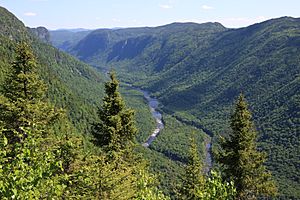
Quebec's highest point at 1,652 metres is Mont d'Iberville, known in English as Mount Caubvick, located on the border with Newfoundland and Labrador in the northeastern part of the province, in the Torngat Mountains. The most populous physiographic region is the Saint Lawrence Lowland. It extends northeastward from the southwestern portion of the province along the shores of the Saint Lawrence River to the Quebec City region, limited to the North by the Laurentian Mountains and to the South by the Appalachians. It mainly covers the areas of the Centre-du-Québec, Laval, Montérégie and Montreal, the southern regions of the Capitale-Nationale, Lanaudière, Laurentides, Mauricie and includes Anticosti Island, the Mingan Archipelago, and other small islands of the Gulf of St. Lawrence lowland forests ecoregion. Its landscape is low-lying and flat, except for isolated igneous outcrops near Montreal called the Monteregian Hills, formerly covered by the waters of Lake Champlain. The Oka hills also rise from the plain. Geologically, the lowlands formed as a rift valley about 100 million years ago and are prone to infrequent but significant earthquakes. The most recent layers of sedimentary rock were formed as the seabed of the ancient Champlain Sea at the end of the last ice age about 14,000 years ago. The combination of rich and easily arable soils and Quebec's relatively warm climate makes this valley the most prolific agricultural area of Quebec province. Mixed forests provide most of Canada's springtime maple syrup crop. The rural part of the landscape is divided into narrow rectangular tracts of land that extend from the river and date back to settlement patterns in 17th century New France.
More than 95% of Quebec's territory lies within the Canadian Shield. It is generally a quite flat and exposed mountainous terrain interspersed with higher points such as the Laurentian Mountains in southern Quebec, the Otish Mountains in central Quebec and the Torngat Mountains near Ungava Bay. The topography of the Shield has been shaped by glaciers from the successive ice ages, which explains the glacial deposits of boulders, gravel and sand, and by sea water and post-glacial lakes that left behind thick deposits of clay in parts of the Shield. The Canadian Shield also has a complex hydrological network of perhaps a million lakes, bogs, streams and rivers. It is rich in the forestry, mineral and hydro-electric resources that are a mainstay of the Quebec economy. Primary industries sustain small cities in regions of Abitibi-Témiscamingue, Saguenay–Lac-Saint-Jean, and Côte-Nord.
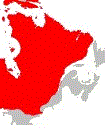
The Labrador Peninsula is covered by the Laurentian Plateau (or Canadian Shield), dotted with mountains such as Otish Mountains. The Ungava Peninsula is notably composed of D'Youville mountains, Puvirnituq mountains and Pingualuit crater. While low and medium altitude peak from western Quebec to the far north, high altitudes mountains emerge in the Capitale-Nationale region to the extreme east, along its longitude. In the Labrador Peninsula portion of the Shield, the far northern region of Nunavik includes the Ungava Peninsula and consists of flat Arctic tundra inhabited mostly by the Inuit. Further south lie the subarctic taiga of the Eastern Canadian Shield taiga ecoregion and the boreal forest of the Central Canadian Shield forests, where spruce, fir, and poplar trees provide raw materials for Quebec's pulp and paper and lumber industries. Although the area is inhabited principally by the Cree, Naskapi, and Innu First Nations, thousands of temporary workers reside at Radisson to service the massive James Bay Hydroelectric Project on the La Grande and Eastmain rivers. The southern portion of the shield extends to the Laurentians, a mountain range just north of the Saint Lawrence Lowland, that attracts local and international tourists to ski hills and lakeside resorts.
The Appalachian region of Quebec has a narrow strip of ancient mountains along the southeastern border of Quebec. The Appalachians are actually a huge chain that extends from Alabama to Newfoundland. In between, it covers in Quebec near 800 km (497 mi), from the Montérégie hills to the Gaspé Peninsula. In western Quebec, the average altitude is about 500 metres, while in the Gaspé Peninsula, the Appalachian peaks (especially the Chic-Choc) are among the highest in Quebec, exceeding 1000 metres.
Climate
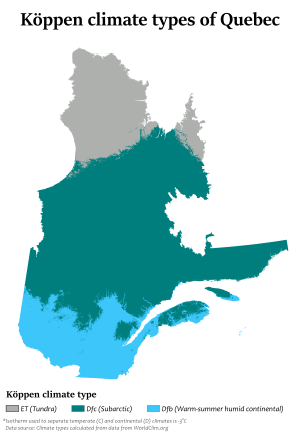
Quebec has three main climate regions. Southern and western Quebec, including most of the major population centres, have a humid continental climate (Köppen climate classification Dfb) with four distinct seasons having warm to occasionally hot and humid summers and often very cold and snowy winters. The main climatic influences are from western and northern Canada and move eastward, and from the southern and central United States that move northward. Because of the influence of both storm systems from the core of North America and the Atlantic Ocean, precipitation is abundant throughout the year, with most areas receiving more than 1,000 millimetres (39 in) of precipitation, including over 300 centimetres (120 in) of snow in many areas. During the summer, severe weather patterns (such as tornadoes and severe thunderstorms) occur occasionally. Most of central Quebec has a subarctic climate (Köppen Dfc). Winters are long, very cold, and snowy, and among the coldest in eastern Canada, while summers are warm but very short due to the higher latitude and the greater influence of Arctic air masses. Precipitation is also somewhat less than farther south, except at some of the higher elevations. The northern regions of Quebec have an arctic climate (Köppen ET), with very cold winters and short, much cooler summers. The primary influences in this region are the Arctic Ocean currents (such as the Labrador Current) and continental air masses from the High Arctic.
The four seasons in Quebec are spring, summer, autumn and winter, with conditions differing by region. They are then differentiated according to the insolation, temperature and precipitation of snow and rain.
At Quebec City, the length of the daily sunshine varies from 8:37 hrs in December to 15:50 hrs in June; the annual variation is much greater (from 4:54 to 19:29 hrs) at the northern tip of the province. From temperate zones to the northern territories of the Far North, the brightness varies with latitude, as well as the Northern Lights and midnight sun.
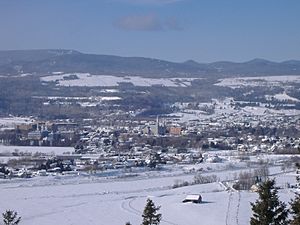
Quebec is divided into four climatic zones: arctic, subarctic, humid continental and East maritime. From south to north, average temperatures range in summer between 25 and 5 °C (77 and 41 °F) and, in winter, between −10 and −25 °C (14 and −13 °F). In periods of intense heat and cold, temperatures can reach 35 °C (95 °F) in the summer and −40 °C (−40 °F) during the Quebec winter, They may vary depending on the Humidex or Wind chill.
The all-time record of the greatest precipitation in winter was established in winter 2007–2008, with more than five metres of snow in the area of Quebec City, while the average amount received per winter is around three metres. March 1971, however, saw the "Century's Snowstorm" with more than 40 centimetres (16 in) in Montreal to 80 centimetres (31 in) in Mont Apica of snow within 24 hours in many regions of southern Quebec. Also, the winter of 2010 was the warmest and driest recorded in more than 60 years.
| Location | July (°C) | July (°F) | January (°C) | January (°F) |
|---|---|---|---|---|
| Montreal | 26/16 | 79/61 | −5/−14 | 22/7 |
| Gatineau | 26/15 | 79/60 | −6/−15 | 21/5 |
| Quebec City | 25/13 | 77/56 | −8/−18 | 17/0 |
| Trois-Rivières | 25/14 | 78/58 | −7/−17 | 19/1 |
| Sherbrooke | 24/11 | 76/53 | −6/−18 | 21/0 |
| Saguenay | 24/12 | 75/54 | −10/−21 | 14/−6 |
| Matagami | 23/9 | 73/48 | −13/−26 | 8/−16 |
| Kuujjuaq | 17/6 | 63/43 | −20/−29 | −4/−20 |
| Inukjuak | 13/5 | 56/42 | −21/−28 | −6/−19 |
Wildlife
The large land wildlife is mainly composed of the white-tailed deer, the moose, the muskox, the caribou, the American black bear and the polar bear. The average land wildlife includes the cougar, the coyote, the eastern wolf, the bobcat (wild cat), the Arctic fox, the fox, etc. The small animals seen most commonly include the eastern grey squirrel, the snowshoe hare, the groundhog, the skunk, the raccoon, the chipmunk and the Canadian beaver.
Biodiversity of the estuary and gulf of Saint Lawrence River consists of an aquatic mammal wildlife, of which most goes upriver through the estuary and the Saguenay–St. Lawrence Marine Park until the Île d'Orléans (French for Orleans Island), such as the blue whale, the beluga, the minke whale and the harp seal (earless seal). Among the Nordic marine animals, there are two particularly important to cite: the walrus and the narwhal.
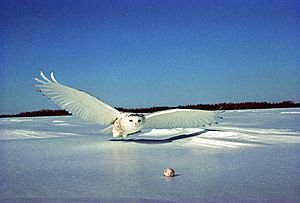
Inland waters are populated by small to large fresh water fish, such as the largemouth bass, the American pickerel, the walleye, the Acipenser oxyrinchus, the muskellunge, the Atlantic cod, the Arctic char, the brook trout, the Microgadus tomcod (tomcod), the Atlantic salmon, the rainbow trout, etc.
Among the birds commonly seen in the southern inhabited part of Quebec, there are the American robin, the house sparrow, the red-winged blackbird, the mallard, the common grackle, the blue jay, the American crow, the black-capped chickadee, some warblers and swallows, the starling and the rock pigeon, the latter two having been introduced in Quebec and are found mainly in urban areas. Avian fauna includes birds of prey like the golden eagle, the peregrine falcon, the snowy owl and the bald eagle. Sea and semi-aquatic birds seen in Quebec are mostly the Canada goose, the double-crested cormorant, the northern gannet, the European herring gull, the great blue heron, the sandhill crane, the Atlantic puffin and the common loon. Many more species of land, maritime or avian wildlife are seen in Quebec, but most of the Quebec-specific species and the most commonly seen species are listed above.
Some livestock have the title of "Québec heritage breed", namely the Canadian horse, the Chantecler chicken and the Canadian cow. Moreover, in addition to food certified as "organic", Charlevoix lamb is the first local Quebec product whose geographical indication is protected. Livestock production also includes the pig breeds Landrace, Duroc and Yorkshire and many breeds of sheep and cattle.
The Wildlife Foundation of Quebec and the Data Centre on Natural Heritage of Quebec (CDPNQ)(French acronym) are the main agencies working with officers for wildlife conservation in Quebec.
Vegetation
Given the geology of the province and its different climates, there is an established number of large areas of vegetation in Quebec. These areas, listed in order from the northernmost to the southernmost are: the tundra, the taiga, the Canadian boreal forest (coniferous), mixed forest and deciduous forest.
On the edge of the Ungava Bay and Hudson Strait is the tundra, whose flora is limited to a low vegetation of lichen with only less than 50 growing days a year. The tundra vegetation survives an average annual temperature of −8 °C (18 °F). The tundra covers more than 24% of the area of Quebec. Further south, the climate is conducive to the growth of the Canadian boreal forest, bounded on the north by the taiga.
Not as arid as the tundra, the taiga is associated with the sub-Arctic regions of the Canadian Shield and is characterized by a greater number of both plant (600) and animal (206) species, many of which live there all year. The taiga covers about 20% of the total area of Quebec. The Canadian boreal forest is the northernmost and most abundant of the three forest areas in Quebec that straddle the Canadian Shield and the upper lowlands of the province. Given a warmer climate, the diversity of organisms is also higher, since there are about 850 plant species and 280 vertebrates species. The Canadian boreal forest covers 27% of the area of Quebec. The mixed forest is a transition zone between the Canadian boreal forest and deciduous forest. By virtue of its transient nature, this area contains a diversity of habitats resulting in large numbers of plant (1000) and vertebrates (350) species, despite relatively cool temperatures. The ecozone mixed forest covers 11.5% of the area of Quebec and is characteristic of the Laurentians, the Appalachians and the eastern lowlands forests. The third most northern forest area is characterized by deciduous forests. Because of its climate (average annual temperature of 7 °C (45 °F)), it is in this area that one finds the greatest diversity of species, including more than 1600 vascular plants and 440 vertebrates. Its relatively long growing season lasts almost 200 days and its fertile soils make it the centre of agricultural activity and therefore of urbanization of Quebec. Most of Quebec's population lives in this area of vegetation, almost entirely along the banks of the St. Lawrence. Deciduous forests cover approximately 6.6% of the area of Quebec.
The total forest area of Quebec is estimated at 750,300 square kilometres (289,700 sq mi). From the Abitibi-Témiscamingue to the North Shore, the forest is composed primarily of conifers such as the Abies balsamea, the jack pine, the white spruce, the black spruce and the tamarack. Some species of deciduous trees such as the yellow birch appear when the river is approached in the south. The deciduous forest of the Saint Lawrence Lowlands is mostly composed of deciduous species such as the sugar maple, the red maple, the white ash, the American beech, the butternut (white walnut), the American elm, the basswood, the bitternut hickory and the northern red oak as well as some conifers such as the eastern white pine and the northern whitecedar. The distribution areas of the paper birch, the trembling aspen and the mountain ash cover more than half of Quebec territory.
Law
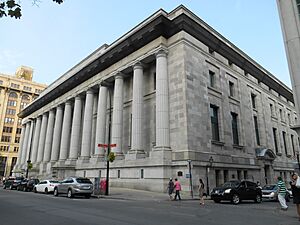
Quebec law is the shared responsibility of the federal and provincial government. The federal government is responsible for criminal law, foreign affairs and laws relating to the regulation of Canadian commerce, interprovincial transportation, and telecommunications. The provincial government is responsible for private law, the administration of justice, and several social domains, such as social assistance, healthcare, education, and natural resources.
Quebec law is influenced by two judicial traditions (civil law and common law) and four classic sources of law (legislation, case law, doctrine and customary law). Private law in Quebec affects all relationships between individuals (natural or juridical persons) and is largely under the jurisdiction of the Parliament of Quebec. The Parliament of Canada also influences Quebec private law, in particular through its power over banks, bankruptcy, marriage, divorce and maritime law. The Droit civil du Québec is the primary component of Quebec's private law and is codified in the Civil Code of Quebec. Public law in Quebec is largely derived from the common law tradition. Quebec constitutional law governs the rules surrounding the Quebec government, the Parliament of Quebec and Quebec's courts. Quebec administrative law governs relations between individuals and the Quebec public administration. Quebec also has some limited jurisdiction over criminal law. Finally, Quebec, like the federal government, has tax law power. Certain portions of Quebec law are considered mixed. This is the case, for example, with human rights and freedoms which are governed by the Quebec Charter of Human Rights and Freedoms, a Charter which applies to both government and citizens.
English is not an official language in Quebec law. However, both English and French are required by the Constitution Act, 1867 for the enactment of laws and regulations, and any person may use English or French in the National Assembly and the courts. The books and records of the National Assembly must also be kept in both languages.
Courts
Although Quebec is a civil law jurisdiction, it does not follow the pattern of other civil law systems which have court systems divided by subject matter. Instead, the court system follows the English model of unitary courts of general jurisdiction. The provincial courts have jurisdiction to decide matters under provincial law as well as federal law, including civil, criminal and constitutional matters. The major exception to the principle of general jurisdiction is that the Federal Court and Federal Court of Appeal have exclusive jurisdiction over some areas of federal law, such as review of federal administrative bodies, federal taxes, and matters relating to national security.
The Quebec courts are organized in a pyramid. At the bottom, there are the municipal courts, the Professions Tribunal, the Human Rights Tribunal, and administrative tribunals. Decisions of those bodies can be reviewed by the two trial courts, the Court of Quebec the Superior Court of Quebec. The Court of Quebec is the main criminal trial court, and also a court for small civil claims. The Superior Court is a trial court of general jurisdiction, in both criminal and civil matters. The decisions of those courts can be appealed to the Quebec Court of Appeal. Finally, if the case is of great importance, it may be appealed to the Supreme Court of Canada.
The Court of Appeal serves two purposes. First, it is the general court of appeal for all legal issues from the lower courts. It hears appeals from the trial decisions of the Superior Court and the Quebec Court. It also can hear appeals from decisions rendered by those two courts on appeals or judicial review matters relating to the municipal courts and administrative tribunals. Second, but much more rarely, the Court of Appeal possesses the power to respond to reference questions posed to it by the Quebec Cabinet. The Court of Appeal renders more than 1,500 judgments per year.
Law enforcement
The Sûreté du Québec is the main police force of Quebec. The Sûreté du Québec can also serve a support and coordination role with other police forces, such as with municipal police forces or with the Royal Canadian Mounted Police (RCMP). The RCMP has the power to enforce certain federal laws in Quebec. However, given the existence of the Sûreté du Québec, its role is more limited than in the other provinces.
Municipal police, such as the Service de police de la Ville de Montréal and the Service de police de la Ville de Québec, are responsible for law enforcement in their municipalities. The Sûreté du Québec fulfils the role of municipal police in the 1038 municipalities that do not have a municipal police force. The Indigenous communities of Quebec have their own police forces.
For offences against provincial or federal laws in Quebec (including the Criminal Code), the Director of Criminal and Penal Prosecutions is responsible for prosecuting offenders in court through Crown attorneys. The Department of Justice of Canada also has the power to prosecute offenders, but only for offences against specific federal laws (ex. ..... Quebec is responsible for operating the prison system for sentences of less than two years, and the federal government operates penitentiaries for sentences of two years or more.
Demographics
In the 2016 census, Quebec had a population of 8,164,361, a 3.3% increase from its 2011 population of 7,903,001. With a land area of 1,356,625.27 km2 (523,795.95 sq mi), it had a population density of 6.0/km2 (16/sq mi) in 2016. Quebec accounts for a little under 23% of the Canadian population. The most populated cities in Quebec are Montreal (1,762,976), Quebec City (538,738), Laval (431,208), and Gatineau (281,501).
In 2016, Quebec's median age was 41.2 years. As of 2020, 20.8% of the population were younger than 20, 59.5% were aged between 20 and 64, and 19.7% were 65 or older. In 2019, Quebec witnessed an increase in the number of births compared to the year before (84,200 vs 83,840) and had a total fertility rate of about 1.6 children born per woman. As of 2020, the average life expectancy was 82.3 years. Quebec in 2019 registered the highest rate of population growth since 1972, with an increase of 110,000 people, mostly because of the arrival of a high number of immigrants. As of 2019, most international immigrants came from China, India or France. In 2016, 30% of the population possessed a postsecondary degree or diploma. Most residents, particularly couples, are property owners. In 2016, 80% of both property owners and renters considered their housing to be "unaffordable". In the 2021 Canadian census, 29.3% of Quebec's population stated their ancestry was of Canadian origin and 21.1% stated their ancestry was of French origin. As of 2021, 18% of Quebec's population were visible minorities.
Religion
Religion, more precisely the Roman Catholic Church, has long occupied a central and integral place in Quebec society, and Catholicism still represents the beliefs of 75% of the Quebec population in 2011. The 2001 census showed the population to be 90.3% Christian (in contrast to 77% for the whole country) with 83.4% Catholic (including 83.2% Roman Catholic); 4.7% Protestant Christian (including 1.2% Anglican, 0.7% United Church; and 0.5% Baptist); 1.4% Orthodox Christian (including 0.7% Greek Orthodox); and 0.8% other Christian; as well as 1.5% Muslim; 1.3% Jewish; 0.6% Buddhist; 0.3% Hindu; and 0.1% Sikh. An additional 5.8% said they had no religious affiliation.
The oldest parish church in North America is the Cathedral-Basilica of Notre-Dame de Québec. Its construction began in 1647, when it was known under the name Notre-Dame-de-la-Paix, and it was finished in 1664. The most frequented place of worship in Quebec is the Basilica of Sainte-Anne-de-Beaupré. This basilica welcomes millions of visitors each year. Saint Joseph's Oratory is the largest place of worship in the world dedicated to Saint Joseph. Many pilgrimages include places such as Saint Benedict Abbey, Sanctuaire Notre-Dame-du-Cap, Notre-Dame de Montréal Basilica, Marie-Reine-du-Monde de Montréal Basilica-Cathedral, Saint-Michel Basilica-Cathedral, and Saint-Patrick's Basilica. Another important place of worship in Quebec is the Anglican Holy Trinity Cathedral, which was erected between 1800 and 1804. It was the first Anglican cathedral built outside the British Isles.
Language
Quebec differs from other Canadian provinces in that French is the only official and preponderant language, while English predominates in the rest of Canada. French is the common language, understood and spoken by 94.46% of the population. Quebec is the only Canadian province whose population is mainly Francophone; 6,102,210 people (78.1% of the population) recorded it as their sole native language in the 2011 Census, and 6,249,085 (80.0%) recorded that they spoke it most often at home. Knowledge of French is widespread even among those who do not speak it natively; in 2011, about 94.4% of the total population reported being able to speak French, alone or in combination with other languages. A considerable number of Quebec residents consider themselves to be bilingual in French and English: about 42.6% of the population (3,328,725 people) report knowing both languages, the highest proportion of any Canadian province.
Québécois French is the most widely used variant. The Office québécois de la langue française oversees the application of the linguistic policy on the territory jointly with the Superior Council of the French Language and the Commission de toponymie du Québec. Their recommendations then become part of the debate on the standard for Quebec French and are represented in Le Grand Dictionnaire terminologique (GDT), the Banque de dépannage linguistique (BDL) and various other works. Through its linguistic recommendations, the GDT fights against the invasion of Frenglish into the French language. Canada is estimated to be home to between 32 and 36 regional French accents, 17 of which can be found in Quebec. There are also people in Quebec who will naturally speak using Standard Québécois or Joual, both of which are considered sociolects rather than regional accents.
The Gendron Commission report of 1968 established the foundations for the white book of the government of Quebec' linguistic policy. Dependent on commissions of inquiry, this policy statement is also accompanied the Charter of the French language ("Bill 101") since 1977. As French's demographic weight continues to decline, Quebec faces the threat of assimilation. Several institutions seek to protect and promote French such as the Office québécois de la langue française, the Superior Council of the French Language, and the Commission de toponymie du Québec.
As of 2011, English is the mother tongue of nearly 650,000 Quebecers (8% of the population). These anglophones, sometimes called Anglo-Québécois, constitute the second largest linguistic group in Quebec. In addition, in 2001, roughly 50,000 people (0.7% of the population) considered their mother tongue to be both French and English. Anglo-Quebecers reside mainly in the west of the island of Montreal (West Island), downtown Montreal and the Pontiac.
Three families of Indigenous languages encompassing eleven languages exist in Quebec: the Algonquian language family (Abenaki, Algonquin, Maliseet-passamaquoddy, Mi'kmaq, and the linguistic continuum of Atikamekw, Cree, Innu-aimun, and Naskapi), the Inuit–Aleut language family (Nunavimmiutitut, an Inuktitut dialect spoken by the Inuit of Nord-du-Québec), and the Iroquoian language family (Mohawk and Wendat). In the 2016 census, 50,895 people in Quebec said they knew at least one Indigenous language. Furthermore, 45,570 people declared having an Indigenous language as their mother tongue. In Quebec, most Indigenous languages are transmitted quite well from one generation to the next with a mother tongue retention rate of 92%.
As of the 2016 census, the most common immigrant languages are Arabic (2.5% of the total population), Spanish (1.9%), Italian (1.4%), Creole languages (mainly Haitian Creole) (0.8%) and Mandarin (0.6%).
Indigenous peoples

In 2021, the Indigenous population of Quebec numbered 205,010 (2.5% of the population), including 15,800 Inuit, 116,550 First Nations people, and 61,010 Métis. There is an undercount, as some Indian bands regularly refuse to participate in Canadian censuses. In 2016, the Mohawk reserves of Kahnawake and Doncaster 17 along with the Indian settlement of Kanesatake and Lac-Rapide, a reserve of the Algonquins of Barriere Lake, were not counted.
The Inuit of Quebec live mainly in Nunavik in Nord-du-Québec. They make up the majority of the population living north of the 55th parallel. There are ten First Nations ethnic groups in Quebec: the Abenaki, the Algonquin, the Attikamek, the Cree, the Wolastoqiyik, the Mi'kmaq, the Innu, the Naskapis, the Huron-Wendat and the Mohawks. The Mohawks were once part of the Iroquois Confederacy. Aboriginal rights were enunciated in the Indian Act and adopted at the end of the 19th century. This act confines First Nations within the reserves created for them. The Indian Act is still in effect today. In 1975, the Cree, Inuit and the Quebec government agreed to an agreement called the James Bay and Northern Quebec Agreement that would extended indigenous rights beyond reserves, and to over two-thirds of Quebec's territory. Because this extension was enacted without the participation of the federal government, the extended indigenous rights only exist in Quebec. In 1978, the Naskapis joined the agreement when the Northeastern Quebec Agreement was signed. Discussions have been underway with the Montagnais of the Côte-Nord and Saguenay–Lac-Saint-Jean for the potential creation of a similar autonomy in two new distinct territories that would be called Innu Assi and Nitassinan.
A few political institutions have also been created over time:
- The Assembly of First Nations Quebec-Labrador
- The Grand Council of the Crees
- The Makivik Corporation
Acadians
The subject of Acadians in Quebec is an important one as more than a million people in Quebec are of Acadian descent, with roughly 4.8 million people possessing one or multiple Acadian ancestors in their genealogy tree, because a large number of Acadians had fled Acadia to take refuge in Quebec during the Great Upheaval. Furthermore, more than a million people have a patronym of Acadian origin.
Quebec houses Acadian communities. Acadians mainly live on the Magdalen Islands and in Gaspesia, but about thirty other communities are present elsewhere in Quebec, mostly in the Côte-Nord and Centre-du-Québec regions. An Acadian community in Quebec can be called a "Cadie", "Petite Cadie" or "Cadien".
Economy
Quebec has an advanced, market-based, and open economy. In 2022, its gross domestic product (GDP) was US$50,000 per person at purchasing power parity. The economy of Quebec is the 46th largest in the world behind Chile and 29th for GDP per person. Quebec represents 19% of the GDP of Canada. The provincial debt-to-GDP ratio peaked at 51% in 2012–2013, and declined to 43% in 2021.
Like most industrialized countries, the economy is based mainly on the services sector. Quebec's economy has traditionally been fuelled by abundant natural resources and a well-developed infrastructure, but has undergone significant change over the past decade. Firmly grounded in the knowledge economy, Quebec has one of the highest growth rates of GDP in Canada. The knowledge sector represents about 31% of Quebec's GDP. In 2011, Quebec experienced faster growth of its research-and-development (R&D) spending than other Canadian provinces. Quebec's spending in R&D in 2011 was equal to 2.63% of GDP, above the European Union average of 1.8%. The percentage spent on research and technology is the highest in Canada and higher than the averages for the Organisation for Economic Co-operation and Development and the G7 countries.
Some of the most important companies from Quebec are: Bombardier, Desjardins, the National Bank of Canada, the Jean Coutu Group, Transcontinental média, Quebecor, the Métro Inc. food retailers, Hydro-Québec, the Société des alcools du Québec, the Bank of Montreal, Saputo, the Cirque du Soleil, the Caisse de dépôt et placement du Québec, the Normandin restaurants, and Vidéotron.
Exports and imports
Thanks to the World Trade Organization (WTO) and the North American Free Trade Agreement (NAFTA), Quebec had, as of 2009[update], experienced an increase in its exports and in its ability to compete on the international market. International exchanges contribute to the strength of the Quebec economy. NAFTA is especially advantageous as it gives Quebec, among other things, access to a market of 130 million consumers within a radius of 1,000 kilometres.
In 2008, Quebec's exports to other provinces in Canada and abroad totalled 157.3 billion CND$, or 51.8% of Quebec's gross domestic product (GDP). Of this total, 60.4% were international exports, and 39.6% were interprovincial exports. The breakdown by destination of international merchandise exports is: United States (72.2%), Europe (14.4%), Asia (5.1%), Middle East (2.7%), Central America (2.3%), South America (1.9%), Africa (0.8%) and Oceania (0.7%).
In 2008, Quebec imported $178 billion worth of goods and services, or 58.6% of its GDP. Of this total, 62.9% of goods were imported from international markets, while 37.1% of goods were interprovincial imports. The breakdown by origin of international merchandise imports is as follows: United States (31.1%), Europe (28.7%), Asia (17.1%), Africa (11.7%), South America (4.5%), Central America (3.7%), Middle East (1.3%) and Oceania (0.7%).
Primary sector
Quebec produces most of Canada's hydroelectricity and is the second biggest hydroelectricity producer in the world (2019). Because of this, Quebec has been described as a potential clean energy superpower. In 2019, Quebec's electricity production amounted to 214 terawatt-hours (TWh), 95% of which comes from hydroelectric power stations, and 4.7% of which come from wind energy. The public company Hydro-Québec occupies a dominant position in the production, transmission and distribution of electricity in Quebec. Hydro-Québec operates 63 hydroelectric power stations and 28 large reservoirs. Because of the remoteness of Hydro-Québec's TransÉnergie division, it operates the largest electricity transmission network in North America. Quebec stands out for its use of renewable energy. In 2008, electricity ranked as the main form of energy used in Quebec (41.6%), followed by oil (38.2%) and natural gas (10.7%). In 2017, 47% of all energy came from renewable sources. The Quebec government's energy policy seeks to build, by 2030, a low carbon economy.
Quebec ranks among the top ten areas to do business in mining in the world. In 2011, the mining industry accounted for 6.3% of Quebec's GDP and it employed about 50,000 people in 158 companies. It has around 30 mines, 158 exploration companies and 15 primary processing industries. While many metallic and industrial minerals are exploited, the main ones are gold, iron, copper and zinc. Others include: titanium, asbestos, silver, magnesium and nickel, among many others. Quebec is also as a major source of diamonds. Since 2002, Quebec has seen an increase in its mineral explorations. In 2003, the value of mineral exploitation reached $3.7 billion.
The agri-food industry plays an important role in the economy of Quebec, with meat and dairy products being the two main sectors. It accounts for 8% of the Quebec's GDP and generate $19.2 billion. In 2010, this industry generated 487,000 jobs in agriculture, fisheries, manufacturing of food, beverages and tobacco and food distribution.
Secondary sector
In 2021, Quebec's aerospace industry employed 35,000 people and its sales totalled C$15.2 billion. Many aerospace companies are active here, including CMC Electronics, Bombardier, Pratt & Whitney Canada, Héroux-Devtek, Rolls-Royce, General Electric, Bell Textron, L3Harris, Safran, SONACA, CAE Inc., and Airbus, among others. Montreal is globally considered one of the aerospace industry's great centres, and several international aviation organisations seat here. Both Aéro Montréal and the CRIAQ were created to assist aerospace companies.
The pulp and paper industry accounted for 3.1% of Quebec's GDP in 2007 and generated annual shipments valued at more than $14 billion. This industry employs 68,000 people in several regions of Quebec. It is also the main -and in some circumstances only- source of manufacturing activity in more than 250 municipalities in the province. The forest industry has slowed in recent years because of the softwood lumber dispute. In 2020, this industry represented 8% of Quebec's exports.
As Quebec has few significant deposits of fossil fuels, all hydrocarbons are imported. Refiners' sourcing strategies have varied over time and have depended on market conditions. In the 1990s, Quebec purchased much of its oil from the North Sea. Since 2015, it now consumes almost exclusively the crude produced in western Canada and the United States. Quebec's two active refineries have a total capacity of 402,000 barrels per day, greater than local needs which stood at 365,000 barrels per day in 2018.
Thanks to hydroelectricity, Quebec is the world's fourth largest aluminum producer and creates 90% of Canadian aluminum. Three companies make aluminum here: Rio Tinto, Alcoa and Aluminium Alouette. Their 9 alumineries produce 2,9 million tons of aluminum annually and employ 30,000 workers.
Tertiary sector
The finance and insurance sector employs more than 168,000 people. Of this number, 78,000 are employed by the banking sector, 53,000 by the insurance sector and 20,000 by the securities and investment sector. The Bank of Montreal, founded in 1817 in Montreal, was Quebec's first bank but, like many other large banks, its central branch is now in Toronto. Several banks remain based in Quebec National Bank of Canada, the Desjardins Group and the Laurentian Bank.
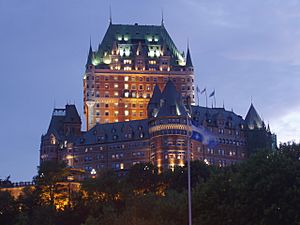
The tourism industry is a major sector in Quebec. The Ministry of Tourism ensures the development of this industry under the commercial name "Bonjour Québec". Quebec is the second most important province for tourism in Canada, receiving 21.5% of tourists' spending (2021). The industry provides employment to over 400,000 people. These employees work in the more than 29,000 tourism-related businesses in Quebec, most of which are restaurants or hotels. 70% of tourism-related businesses are located in or close to Montreal or Quebec City. It is estimated that, in 2010, Quebec welcomed 25.8 million tourists. Of these, 76.1% came from Quebec, 12.2% from the rest of Canada, 7.7% from the United States and 4.1% from other countries. Annually, tourists spend more than $6.7 billion in Quebec's tourism industry.
Quebec's IT sector has 7,600 businesses and employs 140,000 people. Its most developed sectors are telecommunications, multimedia and video game software, computer services, microelectronics, and the components sector. There are currently 115 telecommunications companies established in the province, including Motorola, Ericsson and Mitec. The multimedia and video game sector has been growing fast since the early 2000s. The Digital Alliance, which claims 191 active members in video games, online education, mobility and Internet services, estimates the annual revenue of the sector at $827 million in 2014. The microelectronics sector is made up of more than 100 companies employing 13,000 people. Computer services, software development, and consulting engineering employ 60,000 skilled workers. While the largest IT employers are CMC Electronics, IBM, and Matrox, many other tech companies are present here, including Ubisoft, Electronic Arts, Microids, Strategy First, Eidos, Activision, A2M, Frima Studio, etc.
Approximately 1.1 million Quebecers work in the field of science and technology. In 2007, the Government of Quebec launched the Stratégie québécoise de la recherche et de l'innovation (SQRI) aiming to promote development through research, science and technology. The government hoped to create a strong culture of innovation in Quebec for the next decades and to create a sustainable economy.
Quebec is considered one of world leaders in fundamental scientific research, having produced ten Nobel laureates in either physics, chemistry, or medicine. It is also considered one of the world leaders in sectors such as aerospace, information technology, biotechnology and pharmaceuticals, and therefore plays a significant role in the world's scientific and technological communities. Between 2000 and 2011, Quebec had over 9,469 scientific publications in biomedical research and engineering. The contribution of Quebec in science and technology represented approximately 1% of the research worldwide between the 1980s and 2009.
The province is one of the world leaders in the field of space science and contributed to important discoveries in this field. One of the most recent is the discovery of the complex extrasolar planets system HR 8799. HR 8799 is the first direct observation of an exoplanet in history. The Canadian Space Agency was established in Quebec due to its major role in this research field. A total of four Quebecers have been in space since the creation of the CSA: Marc Garneau, Julie Payette, and David Saint-Jacques as CSA astronauts, plus Guy Laliberté as a private citizen who paid for his trip. Quebec has also contributed to the creation of some Canadian artificial satellites including SCISAT-1, ISIS, Radarsat-1 and Radarsat-2.
Quebec ranks among the world leaders in the field of life science. William Osler, Wilder Penfield, Donald Hebb, Brenda Milner, and others made significant discoveries in medicine, neuroscience and psychology while working at McGill University in Montreal. Quebec has more than 450 biotechnology and pharmaceutical companies which together employ more than 25,000 people and 10,000 highly qualified researchers. Montreal is ranked fourth in North America for the number of jobs in the pharmaceutical sector.
Education
The education system of Quebec, administered by the government of Quebec's Ministry of Education and Higher Education, differs from those of other Canadian provinces. The province has five levels of education: first preschool, then primary school, then secondary school; then CEGEP (see College education in Quebec); and finally university or college. Attached to these levels are the options to also attend professional development opportunities, classes for adults, and continuing education. For every level of teaching, there exists a public network and private network: the public network is financed by taxes while the private options must be paid for by the student. In 2020, school boards were replaced by school service centres.
All universities in Quebec exist by virtue of laws adopted by the National Assembly of Quebec in 1967 during the Quiet Revolution. Their financing mostly comes from public taxes, but the laws under which they operate grants them more autonomy than other levels of education.
Infrastructure
Transportation
Development and security of land transportation in Canada are provided by Transports Québec. Other organizations, such as the Canadian Coast Guard and Nav Canada, provide the same service for the sea and air transportation. The Commission des transports du Québec works with the freight carriers and the public transport.
The réseau routier québécois (Quebec road network) is managed by the Société de l'assurance automobile du Québec (SAAQ; Quebec Automobile Insurance Corporation) and consists of about 185,000 km (115,000 mi) of highways and national, regional, local, collector and forest roads. In addition, Quebec has almost 12,000 bridges, tunnels, retaining walls, culverts and other structures such as the Quebec Bridge, the Laviolette Bridge and the Louis-Hippolyte Lafontaine Bridge–Tunnel.
In the waters of the Saint Lawrence there are eight deep-water ports for the transhipment of goods. In 2003, 3886 cargo and 9.7 million tonnes of goods transited the Quebec portion of the Saint Lawrence Seaway.
Concerning rail transport, Quebec has 6,678 km (4,150 mi) of railways integrated in the large North American network. Although primarily intended for the transport of goods through companies such as the Canadian National (CN) and the Canadian Pacific (CP), the Quebec railway network is also used by inter-city passengers via Via Rail Canada and Amtrak. In April 2012, plans were unveiled for the construction of an 800 km (497 mi) railway running north from Sept-Îles, to support mining and other resource extraction in the Labrador Trough.
Quebec's air network includes 43 airports that offer scheduled services on a daily basis. In addition, the Government of Quebec owns airports and heliports to increase the accessibility of local services to communities in the Basse-Côte-Nord and northern regions.
Various other transport networks crisscross the province of Quebec, including hiking trails, snowmobile trails and bike paths. The Green Road is the largest at nearly 4,000 km (2,500 mi) in length.
Healthcare
Quebec has a health policy that emphasizes prevention, is based on the analysis of health-related data, and evolves with the needs of the population. Similar to other developed economies, the public health policies implemented in Quebec have extended the life expectancy of its population since the mid-20th century.
Health and social services are part of the same administration. The Quebec health system is also public, which means that the government acts as the main insurer and administrator, that funding is provided by general taxation, and that patients have access to care regardless of their income level.
There are 34 health establishments in Quebec, 22 of which are an Integrated Health and Social Services Centre (CISSS). They ensure the distribution of different services on the territories they are assigned to. Quebec has approximately 140 hospitals for general or specialised care (CHSGS). Quebec also has other types of establishments in its healthcare system, such as Centre local de services communautaires (CLSC), Centre d'hébergement et de soins de longue durée (CHSLD), Centre de réadaptation and Centre de protection de l'enfance et de la jeunesse. Finally, there are private healthcare establishments (paid for directly by the patient) like Groupe de médecine de famille, pharmacies, private clinics, dentists, community organisations and retirement homes.
A 2021 Ipsos poll found that 85% of Quebecers agree that their health care system is too bureaucratic to respond to the needs of the population and in 2023 found that less than half of Quebecers are satisfied with the provincial health care system.
Housing
In 2021, 59.9% of Quebec's residents were property owners. In 2019, among property owners, 34% were couples with kids, 33% were couples without children, 22% lived alone, 8% were single parents, and 3% were something else. Among renters, 16% were couples with kids, 13% were couples without children, 51% lived alone, 13% were single parents, and 7% were something else.
Since the 1980s, the average price of a single-family home has doubled every 10 years, going from $48,715 in 1980 to $424,844 in 2021. Since the average salary did not follow these increases, Quebec homes are 10 times more expensive than they were 40 years ago. In 2022, the cities with the most severe housing shortages were Granby, with a vacancy rate of 0,1%, followed by Marieville (0,1%), Rimouski (0,2%), Drummondville (0,2%) and Rouyn-Noranda (0,3%).
Culture
Quebec has developed its own unique culture from its historic New France roots. Its culture also symbolizes a distinct perspective: being a French-speaking nation surrounded by a bigger English-speaking culture.
The Quartier Latin (English: Latin Quarter) of Montreal, and Vieux-Québec (English: Old Quebec) in Quebec City are two hubs of metropolitan cultural activity. Life in the cafés and "terrasses" (outdoor restaurant terraces) reveals a Latin influence in Quebec's culture, with the théâtre Saint-Denis in Montreal and the Capitole de Québec theatre in Quebec City being among the principal attractions.
A number of governmental and non-government organizations support cultural activity in Quebec. The Conseil des arts et des lettres du Québec (CALQ) is an initiative of the Ministry of Culture and Communications (Quebec). It supports creation, innovation, production, and international exhibits for all cultural fields of Quebec. The Société de développement des entreprises culturelles (SODEC) works to promote and fund individuals working in the cultural industry. The Prix du Québec is an award given by the government to confer the highest distinction and honour to individuals demonstrating exceptional achievement in their respective cultural field. Other awards include the Athanase David Awards (Literature), Félix Awards (Music), Gémeaux Awards (Television and film), Jutra Awards (Cinema), Masques Awards (Theatre), Olivier Guimond Awards (Humour) and the Opus Awards (Concert music).
Performing arts
Traditional music is imbued with many dances, such as the jig, the quadrille, the reel and line dancing. Traditional instruments include harmonica, fiddle, spoons, jaw harp and accordion. The First Nations and the Inuit of Quebec also have their own traditional music. Quebec's most popular artists of the last century include the singers Félix Leclerc, Gilles Vigneault, Kate and Anna McGarrigle and Céline Dion. The Association québécoise de l'industrie du disque, du spectacle et de la vidéo (ADISQ) was created in 1978 to promote the music industry in Quebec. The Orchestre symphonique de Québec and the Montreal Symphony Orchestra are respectively associated with the Opéra de Québec and the Opéra de Montreal whose performances are presented at the Grand Théâtre de Québec and at Place des Arts. The Ballets Jazz de Montreal, the Grands Ballets and La La La Human Steps are three important professional troupes of contemporary dance.
Among the theatre troupes are the Compagnie Jean-Duceppe, the Théâtre La Rubrique, and the Théâtre Le Grenier. In addition to the network of cultural centres in Quebec, the venues include the Monument-National and the Rideau Vert (green curtain) Theatre in Montreal, and the Trident Theatre in Quebec City. The National Theatre School of Canada and the Conservatoire de musique et d'art dramatique du Québec form the future players.
Several circus troupes were created in recent decades, the most important being the Cirque du Soleil. Among these troops are contemporary, travelling and on-horseback circuses, such as Les 7 Doigts de la Main, Cirque Éloize, Cavalia, Kosmogonia, Saka and Cirque Akya. The National Circus School and the École de cirque de Québec were created to train future Contemporary circus artists. Tohu, la Cité des Arts du Cirque was founded in 2004 to disseminate the circus arts.
Comedy is a vast cultural sector. Quebec has created and is home to several different comedy festivals, including the Just for Laughs festival in Montreal, as well as the Grand Rire festivals of Quebec, Gatineau and Sherbrooke. The Association des professionnels de l'industrie de l'humour (APIH) is the main organization for the promotion and development of the cultural sector of humour in Quebec and the National School of Humour, created in 1988, trains future humorists in Quebec.
Media
The Cinémathèque québécoise has a mandate to promote the film and television heritage of Quebec. The National Film Board of Canada (NFB), a federal Crown corporation, provides for the same mission in Canada. The Association of Film and Television in Quebec (APFTQ) promotes independent production in film and television. While the Association of Producers and Directors of Quebec (APDQ) represents the business of filmmaking and television, the Association of Community Radio Broadcasters of Quebec (ARCQ) (French acronym) represents the independent radio stations. Several movie theatres across Quebec ensure the dissemination of Quebec cinema. With its cinematic installations, such as the Cité du cinéma and Mel's studios, the city of Montreal is home to the filming of various productions. The state corporation Télé-Québec, the federal Crown corporation CBC, general and specialized private channels, networks, independent and community radio stations broadcast the various Quebec téléromans, the national and regional news, and other programming. Les Rendez-vous du cinéma québécois is a festival surrounding the ceremony of the Jutra Awards Night that rewards work and personalities of Quebec cinema. The Artis and the Gemini Awards gala recognize the personalities of television and radio industry in Quebec and French Canada. The Film Festival of the 3 Americas, the Festival of International Short Film, the World Film Festival and the Festival of New Cinema are other annual events surrounding the film industry in Quebec.
Popular comedy shows include Cré Basile, Le zoo du Capitaine Bonhomme, Lundi des Ha! Ha !, Démons du midi, La petite vie, Les Bougon, and Le sketch show. There are also many comedy and cartoon shows created for children, such as La boîte à surprise, Bobino, Le pirate Maboule, Fanfreluche, La Ribouldingue, Les 100 Tours de Centour, Patofville, Passe-Partout, Robin et Stella, Iniminimagimo, Vazimolo, Télé-Pirate, Bibi et Geneviève, Watatatow, Caillou, Cornemuse, Macaroni tout garni, Toc toc toc, Ramdam, and Tactik.
In the realm of literature and international publishing, the Québec Édition group is a committee created by the National Association of Book Editors dedicated to the international influence of French-language publishings from Quebec and Canada.
Literature and folklore
Quebec's French-speaking populace has the second largest body of folktales in Canada (the first being First Nations). When the early settlers arrived from France in the 17th century, they brought with them popular tales from their homeland, which were adapted to the local context. Many were passed on through generations by raconteurs, or storytellers. Almost all of the stories native to Quebec were influenced by Christian dogma and superstitions. The Devil, for instance, appears often as either a person, an animal or monster, or indirectly through Demonic acts. Various tales and stories are told through oral tradition, such as, among many others, the legends of the Bogeyman, the Chasse-galerie, the Black Horse of Trois-Pistoles, the Complainte de Cadieux, the Corriveau, the dancing devil of Saint-Ambroise, the Giant Beaupré, the monsters of the lakes Pohénégamook and Memphremagog, of Quebec Bridge (called the Devil's Bridge), the Rocher Percé and of Rose Latulipe, for example.
From New France, Quebec literature was first developed in the travel accounts of explorers. The Moulin à paroles traces the great texts that have shaped the history of Quebec. The first to write the history of Quebec, since its discovery, was the historian François-Xavier Garneau. Many Quebec poets and prominent authors marked their era and today remain anchored in the collective imagination, like, among others, Philippe Aubert de Gaspé, Octave Crémazie, Honoré Beaugrand, Émile Nelligan, Lionel Groulx, Gabrielle Roy, Hubert Aquin, Michel Tremblay, Marie Laberge, Fred Pellerin and Gaston Miron. The regional novel from Quebec is called Terroir novel and is a literary tradition specific to the province.
Popular French-language contemporary writers include Louis Caron, Suzanne Jacob, Yves Beauchemin, and Gilles Archambault. Well-known English-language writers from Quebec include Leonard Cohen, Mordecai Richler, and Neil Bissoondath.
Art and architecture
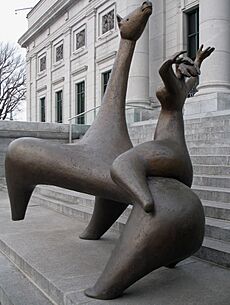
The art of Quebec has developed around the specific characteristics of its landscapes and cultural, historical, social and political representations. The development of Quebec masterpieces in painting, printmaking and sculpture is marked by the contribution of artists such as Louis-Philippe Hébert, Cornelius Krieghoff, Alfred Laliberté, Marc-Aurèle Fortin, Marc-Aurèle de Foy Suzor-Coté, Jean Paul Lemieux, Clarence Gagnon, Adrien Dufresne, Alfred Pellan, Jean-Philippe Dallaire, Charles Daudelin, Arthur Villeneuve, Jean-Paul Riopelle, Paul-Émile Borduas and Marcelle Ferron.
The fine arts of Quebec are displayed at the Quebec National Museum of Fine Arts, the Montreal Museum of Contemporary Art, the Montreal Museum of Fine Arts, the Quebec Salon des métiers d'art and in many art galleries. The Montreal School of Fine Arts forms the painters, printmakers and sculptors of Quebec.
Quebec's architecture is characterized by its unique Canadien-style buildings as well as the juxtaposition of a variety of styles reflective of Quebec's history. When walking in any city or town, one can come across buildings with styles congruent to Classical, Neo-Gothic, Roman, Neo-Renaissance, Greek Revival, Neo-Classical, Québécois Neo-Classical, Victorian, Second Empire, Modern, Post-modern or Skyscrapers.
Canadien-style houses and barns were developed by the first settlers of New France along the banks of the Saint Lawrence River. These buildings are rectangular one-storey structures with an extremely tall and steep roof, sometimes almost twice as tall as the house below. Canadien-style churches also developed and served as landmarks while traversing rural Quebec.
Heritage
Several sites, houses and historical works reflect the cultural heritage of Quebec, such as the Village Québécois d'Antan, the historical village of Val-Jalbert, the Fort Chambly, the national home of the Patriots, the Chicoutimi pulp mill (Pulperie de Chicoutimi), the Lachine Canal and the Victoria Bridge. As of December 2011, there are 198 National Historic Sites of Canada in Quebec. These sites were designated as being of national historic significance.
Various museums tell the cultural history of Quebec, like the Museum of Civilization, the Museum of French America, the McCord Museum or the Montreal Museum of Archaeology and History in Pointe-à-Callière, displaying artifacts, paintings and other remains from the past of Quebec. Notable schools include the Conservatoire de musique et d'art dramatique du Québec, the École nationale de théâtre du Canada and the École nationale de cirque. Notable public agencies to catalogue and further develop Quebec's culture include the Bibliothèque et Archives nationales du Québec, the Conseil des arts et des lettres du Québec and Télé-Québec. The Association Quebecoise des Loisirs Folkloriques is an organization committed to preserving and disseminating Quebec's folklore heritage.
Cuisine
The historical context of 'traditional' Quebec cuisine is from the fur trade period and many dishes have a high fat or lard content. From the early 17th century, French settlers populating North America were interested in a new cuisine to confront the climate and the needs arising from the work of colonization. Mindful of the same nutritional needs as settlers from Acadia, it has many similarities with Acadian cuisine. Quebec's cuisine has a strong French and Irish influence, although many aspects of Canadian aboriginal cuisine have also had a significant impact on Quebec cuisine. Quebec is most famous for its Tourtière, Pâté Chinois and Poutine. The temps des sucres (sugar season) is one of the oldest of Quebec culinary traditions. During springtime, many Quebecers go to the cabane à sucre (sugar house) for a traditional meal. The Jewish community of Montreal has contributed Montreal-style bagels and smoked meat which is similar to pastrami.
Quebec has produced beer since the beginning of colonization especially with the emergence of spruce beer. In 1668, Jean Talon founded a brewery in Quebec City, but it closed a decade later. Although many people tried to produce a beer between the 17th and 18th centuries, it is only since the 1980s that the industries had produced on a larger scale. Today there are nearly a hundred breweries and companies, including Unibroue, Molson Coors, Labatt and many others. Quebec also produces wine, ice wine and ice cider.
Quebec has produced cheese for centuries. The first cheese-making school in North America was established in Saint-Denis-de-Kamouraska in 1893. It was at this moment that the monks of La Trappe of Oka began to produce the famous Oka cheese. Today there are over 300 different cheeses in Quebec.
-
A classic poutine from La Banquise in Montreal.
-
Montreal-style smoked meat from Schwartz's in Montreal
-
La fin du monde by Unibroue won the World Beer Awards 2011 for the best Blonde Ale in the North America.
Sports
Sports in Quebec constitutes an essential dimension of Quebec culture. Ice hockey remains the national sport. This sport was played for the first time on March 3, 1875, in Montreal and has been promoted over the years by numerous achievements, including the centenary of the Montreal Canadiens. Other major sports include Canadian football with the Montreal Alouettes, soccer with Club de Foot Montréal, the Grand Prix du Canada Formula 1 racing with drivers such as Gilles Villeneuve and Jacques Villeneuve, and professional baseball with the former Montreal Expos. Quebec has hosted several major sporting events, including the 1976 Summer Olympics, the Fencing World Championships in 1967, track cycling in 1974, and the Transat Québec-Saint-Malo race created in 1984.
Quebec athletes have performed well at the Winter Olympics over recent years. They won 12 of Canada's 29 medals at the most recent Winter Olympics in Pyeongchang (2018); they won 12 of the 27 Canadian medals in Sochi (2014); and 9 of the 26 Canadian medals in Vancouver (2010).
Holidays and symbols
St-Jean-Baptiste Day is one of Quebec's biggest holidays. In 1977, the Quebec Parliament declared June 24, the day of La Saint-Jean-Baptiste, to be Quebec's National Holiday. La Saint-Jean-Baptiste, or La St-Jean, honours French Canada's patron saint, John the Baptist. On this day, the song "Gens du pays", by Gilles Vigneault, is often heard. The song À la claire fontaine was the anthem of the New France, Patriots and French Canadian, then replaced by O Canada, but "Gens du pays" is preferred by many Quebecers to be the national anthem of Quebec.
National Patriots' Day, a statutory holiday in Quebec, is also a unique public holiday, which honours the patriotes with displays of the patriote flag, music, public speeches, and ceremonies. Le Vieux de '37 ("The Old Man of '37"), an illustration by Henri Julien that depicts a patriot of this rebellion, is sometimes added at the centre of Patriote flags. Moving Day is a tradition where leases terminate on July 1. This creates a social phenomenon where everyone seems to be moving out at the same time.
Other distinct holiday traditions include the Réveillon, a giant feast and party which takes place during Christmas Eve and New Year's Eve and goes on until midnight. Traditional dishes like tourtière or cipâte are offered, and rigaudon, spoon or violin may be played. Finally, April Fools' Day is called Poisson d'Avril ("April's Fish") because while pulling pranks is still important, there is another major tradition: sticking fish-shaped paper cutouts to people's backs without them noticing.
In 1939, the government of Quebec unilaterally ratified its coat of arms to reflect Quebec's political history: French rule (gold lily on blue background), followed by British rule (lion on red background), followed by Canadian rule (maple leaves). Je me souviens ("I remember") is an official part of the coat of arms and has been the official licence plate motto since 1978, replacing the previous motto: La belle province ("the beautiful province"), still used as a nickname for the province. The fleur-de-lis, one of Quebec's most common symbols, is an ancient symbol of the French monarchy. Finally, the Great Seal of Quebec is used to authenticate documents issued by the government of Quebec.
The first members of the Saint-Jean-Baptiste Society created the Carillon Sacré-Coeur flag, which consisted of a white cross on an azure background with white fleur-de-lis in each corner and a Sacred Heart surrounded by maple leaves in the centre; it was based on the French merchant flag flown by Champlain and the Flag of Carillon. The Carillon Sacré-Coeur and French merchant flag went on to be the major inspirations for creating Quebec's current flag in 1903, called the Fleurdelisé. The Fleurdelisé replaced the Union Jack on Quebec's Parliament Building on January 21, 1948.
Emblems of Quebec
There are three official emblems in Quebec:
- Iris versicolor Linné. — Iris versicolore. — Clajeux. — (Larger blue-flag), the floral emblem of Quebec since 1999.
Through the variety and harmony of the colors of its flower, the versicolor iris perfectly illustrates the cultural diversity of Quebec. It also underlines the importance of water and wetlands for the balance of nature.
- Bubo scandiacus. — Harfang des neiges. — Snowy owl, the avian emblem of Quebec since 1987.
The owl symbolizes the whiteness of Quebec winters, roots in a semi-northern climate and extension over a very vast territory.
- Betula alleghaniensis Britton. — Bouleau des Alléghanys. — Merisier. — Yellow birch, forest emblem since 1993.
Colloquially called Merisier, yellow birch, in addition to being one of the best-known noble woods in Quebec, is distinguished by the variety of its uses and by its commercial value. It was picked to emphasize the importance Québécois give to the forests.
Quebec's diaspora
The earliest immigrants to the Canadian prairies were French Canadians from Quebec. Many Franco-Albertans, Fransaskois and Franco-Manitobans are descended from them.
From the mid-1800s to the Great Depression, Quebec experienced the Grande Hémorragie ("Great Hemorrhaging"), a massive emigration of 900,000 people from Quebec to New England. French Canadians often established themselves in Little Canadas in many industrial New England centres. Of the 900,000 Québécois who emigrated, about half returned. Most of the descendants of those who stayed are now assimilated, though a few Franco-Americans remain, speaking New England French.
Some tried to slow the Grande Hémorragie by redirecting people north, which resulted in the founding of many regions in Quebec (ex. Saguenay-Lac-St-Jean, Val-d'Or) but also in Northeastern Ontario. The northeastern Franco-Ontarians of today, who live in Timmins, Hearst, Moosonee and Sault Sainte Marie, among others, are the descendants of emigrants from Quebec who worked in the mines of the area.
In recent times, snowbirds often migrate to southern Florida during the winter, resulting in the emergence of temporary "Québécois regions".
See also
 In Spanish: Quebec para niños
In Spanish: Quebec para niños




